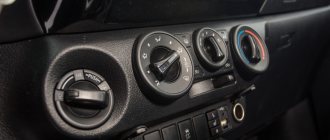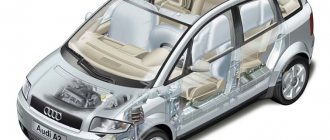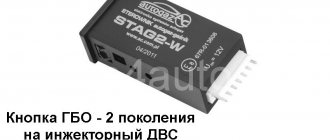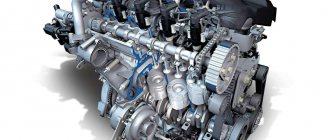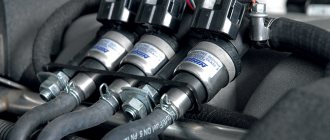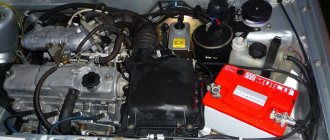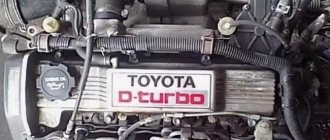What does HBO 2 for the injector consist of?
8. Anti-slam valve. 9. Injector operation emulator. 10. Lambda probe emulator. 11. Hard and soft tubes.
The principle of operation of 2nd generation gas equipment on a car with an injection engine
Gas is supplied to cars with carburetor engines using a carburetor. In injection engines, this is not possible, due to the lack of a carburetor; in this case, to connect the LPG, a mixer with an anti-pop is installed in front of the throttle valve.
The principle of operation of the installation is the same as in carburetor cars, but taking into account several features, which we will dwell on in more detail.
Gasoline pump
As for the fuel pump. You cannot turn it off, otherwise the fuel hoses will dry out. In addition, the car must be started on gasoline, warmed up to at least 50 degrees Celsius, and only then switch to gas.
Lambda probe emulator
Another feature of this equipment is the presence of a “Lambda probe operation emulator”. It is necessary to prevent the "check" error. This error occurs when the computer “realizes” that it cannot control the quality of the mixture and tries to put the car into emergency mode. Thanks to the Emulator, this will not happen; it will show the computer the data suitable for it. It must be remembered that there is simply no automatic adjustment of mixture quality on the 2nd generation, and a regular lambda probe will not work here. Adjustment of the quality of the gas-air mixture is carried out only on the gearbox screws and the gas line mechanically.
Mixer-Anti-cotton
Designed to protect against backfires of the gas mixture. “Anti-clap” is mounted in front of the mixer. If it is missing, there is a high probability of an explosion in the air flow meter. Also, if the gas-air mixture ignites, the housing of the air filter itself may rupture.
Source
Price for 2, 4, 5 generations of HBO
Naturally, car owners ask themselves: what is the cost of installing gas equipment on a car? It is difficult to give specific figures right away: you definitely need to find out what kind of engine the car has - carburetor or injection, how many cylinders it has, and what volume of gas cylinder is needed.
The price of 2nd generation gas equipment per car will be in the following range:
The price of 4th generation LPG for domestic cars starts at 27,000 rubles, whether it is an engine with 4, 6 or 8 cylinders. The table below shows what the price of a 4th generation LPG injector for foreign cars depends on and what it will be.
The price of 4th generation gas equipment per car is clearly more expensive for foreign cars with more than four cylinders.
The cost of the 5th generation LPG with installation is much higher - from about 80,000 rubles for a 4-cylinder engine and from 100,000 rubles for internal combustion engines with 6 cylinders. Obviously, the price of the 5th generation LPG is too high for the installation of this system to become very popular.
How to install and configure 2nd generation HBO on injection and carburetor cars
The release of more modern cars forces manufacturers of gas systems to develop, moving with the times. Although the number of obsolete vehicles is inevitably decreasing, in pursuit of savings on fuel and car maintenance costs, 2nd generation LPG does not lose popularity among car owners. Its installation and adjustment does not require special equipment. Therefore, it is possible to install gas equipment on a car yourself in the conditions of an average garage.
What does the equipment consist of and how does it work?
2nd generation LPG (propane or methane) is used in cars with injection and carburetor engines. Such equipment is best suited for cars up to the 3rd environmental class (Euro 0,1,2). Starting from Euro 3, it is more rational to install the 4th generation of gas equipment.
Device on the carburetor
The second generation kit includes:
The operating principle of 2nd generation equipment on a carburetor engine is as follows:
The engine starts and warms up using gasoline. Next, the key is moved to the neutral position to produce fuel from the carburetor float chamber. Thus, the solenoid valve is activated, which shuts off the gasoline supply.
After which the switch is set to the gas supply position, activating the gas valve. So the gas, which is in a liquid state in the cylinder, flows through the multivalve and the main pipeline to the reducer. At this stage, the mixture undergoes preliminary rough cleaning.
When the gearbox warms up from the engine coolant, the liquefied gas is converted into steam. In the vapor phase, the fuel, passing through the power register, mixes with air in the carburetor.
To do this, in the 2nd generation HBO system, an injection mixer (spacer) or gas inserts are installed on the carburetor.
Then the finished gas mixture, entering through the intake manifold and cylinder head valves, is ignited by a spark in the combustion chamber of the engine cylinder.
To switch back to base fuel, the LPG button is moved to the position of working on gasoline, bypassing the neutral position.
Diagram on engines with injector
Here the equipment differs in several components:
There are no radical differences in the operating principles of both gas equipment schemes. Major changes have been made to the design of the gas equipment due to the presence in a car with an injector of injectors for supplying fuel (or a mono injector - one nozzle for all cylinders). Which are controlled by the standard engine control unit (ECU).
The engine can switch to gas in semi-automatic mode (middle position of the toggle switch). Until the engine reaches a given number of rpm (1500-2000), gasoline is supplied to the combustion chamber. Then the switch to gas occurs automatically.
An injector emulator is needed to turn off gasoline injectors; it also sends a signal to the controller (ECU) simulating their operation. Due to this, the control unit does not display an error (“check engine”) about non-working injectors through an alarm on the instrument panel.
HBO for engines with direct injection
Gas equipment on a direct injection engine. The first engines using gasoline fuel directly into the combustion chamber began to be used in cars in the 90s of the 20th century. Modern automakers, for the sake of economy and the environment, have begun to more often equip their cars with similar power units. In connection with this, the owners of these cars have questions about the possibility of installing LPG on direct injection, as well as what consequences of the conversion may arise. The Japanese Mitsubishi began using the direct injection system in mass production, marking engines GDI (Gasoline Direct Injection - direct injection of gasoline). The VAG concern labels these engines FSI, TFSI, TSI, which are widely used in Volkswagen , Shkoda , Audi , and Seat . For other manufacturers it is: Fiat (GTS). BMW (THP). Pego (HPI). Mercedes-Benz (CGI). Mazda (DISI). Ford (Ecoboost).
Regardless of the name of the system, the essence is the same for everyone - fuel is supplied directly to the cylinder, bypassing the intake manifold and valves. A special gasoline injector, which operates under high injection pressure (30-120 atm), is located directly in the combustion chamber. On conventional engines, the injectors are located in the manifold in front of the valves. 4th generation LPG and direct injection: solution to the problem. On a GDI engine, fuel injector cooling occurs when gasoline is supplied. If you install standard 4th generation gas equipment on it using the classical method, the operating scheme of which involves turning off the standard injectors, then under the influence of high temperature the gasoline injectors will simply burn out. HBO manufacturers have found a solution by using binary fuel injection technology. What this means is that while the car is running on gas fuel, rare additional injections of gasoline occur through the gasoline injector (1-3). As a rule, the share of the gasoline component is in the range of 10-30%. Installing HBO for direct injection does not differ from the standard one. With proper installation there are no problems. The main difference between the system is the different operating algorithm of the electronic control unit. The system is able to provide the ratio of gasoline to gas: -BRC Sequent Direct Injection (Italy) 10/90%. The cost of 4th generation kits with direct injection is over 25 thousand rubles (the final price depends on the engine power and equipment for a specific car). BRC Sequent Direct Injection KITS (Italy) The payback period for such gas equipment will be longer and the economic indicators will also be lower than on machines with distributed fuel supply. But as practice shows, and also based on numerous reviews from owners of such cars, fuel costs will be significantly reduced. To select a set of gas equipment with direct injection, you need to know:
- Car brand;
- Engine's type;
- Engine power;
GAS EQUIPMENT SELECTION TABLE ☜ If you could not find your car, you need to send an email
the following data:
- Full name of the person making the request;
- Contact number for communication;
- PTS scan (only the first page with car data, the PTS number can be hidden, it is not needed),
after receiving the request, we send a scan of the PTS to the manufacturer to obtain the correct selection of a set of LPG equipment; the time for this request takes from 5 to 10 working days.
Installation of HBO 2nd generation
Equipment setup
As an example, consider the configuration option for a popular gearbox from Tomasetto (Tomasetto AT-07 electronic). Adjustment of 2nd generation Lovato gearboxes and its full analogues, such as Atiker and Torelli, is performed in a similar manner.
Before starting work, make sure that all engine systems are in good condition. The air filter has been changed, the ignition has been adjusted, and the coolant level is normal. Drain the condensate from the gearbox, if it is not new, make sure it is in good condition.
In order to adjust second-generation gas equipment with your own hands, you need to warm up the engine to operating temperature on gasoline, switch to gas and turn off the engine. From now on, we will separate the tuning options for different types of engines.
Correct adjustment of 2nd generation HBO on a carburetor with your own hands
Setting up 2nd generation HBO on an injector
In this case, it is convenient to use a lambda probe emulator. The setting can be considered correct when the indication on it (LED) glows red at idle. If this condition is not met, you can unscrew the x/x screw until the engine speed stabilizes. Also, if you have a device (gas analyzer), you can use it to adjust the gas equipment even more accurately.
5. Make further adjustments during sea trials. If the car does not develop enough power, slightly release the gas supply with the register screw.
Source
Malfunctions of the 2nd generation LPG injectors
| Problem | Possible reasons | Search methods | Remedies in case of compliance |
| The internal combustion engine does not run on gas, does not start or starts poorly | Gas is not flowing | Check the gas supply multivalve output | Repair, if repair is impossible, replace |
| Check the output from the gas valve | Blow out the line, replace the filter, replace the gas valve | ||
| Check gearbox output | Carry out repairs, if repair is impossible, replace | ||
| When checking the gas supply, the gas should come out in the liquid phase (white thick mist). | |||
| Incorrect amount of gas supplied to the engine | LPG adjustment is broken | Make adjustments | |
| The gearbox has failed | Carry out repairs, if repair is impossible, replace | ||
| The tightness of the intake system is broken | Eliminate air leaks | ||
| Petrol is supplied simultaneously with gas | Check the gas valve | Repair or replace | |
| The injector emulator is faulty | Repair or replace | ||
| Gas reducer freezes | Coolant circulation is disrupted | Low coolant level | Add antifreeze or antifreeze to the level |
| Channels are clogged | Clean the channels | ||
| The tightness of the gas valves is broken | When the engine is stopped, gas escapes from the gearbox | Repair the valves or replace them | |
| Insufficient engine warm-up | Car cooling system is faulty | Warm up the engine to the desired temperature | |
| Contact service for repair | |||
| Unstable engine idle | The idle system on the carburetor is faulty | Check engine idle when running on gasoline | Repair the carburetor |
| Gearbox adjustment is out of order | Perform adjustment | ||
| Filling the reducer with gas condensate | Drain condensate from gearbox | ||
| The engine does not develop speed after idling, failures in operation. | Insufficient gas quantity. | The multivalve, line, and filter are clogged. | Check and clear jams |
| Fuel misfires | Malfunction in the car's ignition system | Check spark plugs, high-voltage wires and ignition coil | |
| There is backfire in the intake manifold. | Fuel misfires | Malfunction in the car's ignition system | Check spark plugs, high-voltage wires and ignition coil |
| Lean gas-air mixture | Air leak into the intake manifold | Find the cause of the leak and eliminate it | |
| Incorrect gas adjustment | Make adjustments | ||
| Malfunction in the gas distribution system | The marks on the timing belt (chain) are knocked off | Install by tags | |
| The gaps between the valves and seats in the engine are broken | Adjust the gaps |
* if you don’t find the problem you need, describe your problem in the comments
How to connect all elements of the gas system
Each 4th generation LPG kit must contain a connection diagram for an injection car; the system is installed according to it. For different manufacturers it may differ slightly (for example, the electrical circuit), but the general installation principle for all types of gas equipment is the same.
The installation process begins from the engine compartment. To begin with, it is advisable to protect the paintwork of the car by covering the lining and fenders with rag material. Remove the battery terminals.
Correct installation of gas injectors
In order to install HBO injectors, it is necessary to dismantle the intake manifold. You can, of course, not remove it, but then you are likely to encounter a number of difficulties:
If a plastic manifold is not so critical, then duralumin/aluminum, especially cast iron, is unacceptable to drill on the engine. This can lead to damage to the CPG (cylinder-piston group) or valves and their seats. The uniformity of gas supply depends on the correct location of the fittings.
So, after dismantling the manifold, as close as possible to the intake valves and the holes of the gasoline injectors, at the same angle (approximately 45˚), towards the center of the intake passage (along the air flow), we drill holes with a diameter of 4.8 mm. Also, to connect the vacuum, we make a hole in the manifold receiver, closer to the throttle valve.
Here it is important not to damage the walls of the wells of the standard injectors; also, mark and mark the drilling points in advance with a marker. Consider the possibility of reassembly so that the fittings do not interfere with the fastening of the manifold to the cylinder head.
Then, use an M6 tap to cut the thread and screw in each fitting using a hexagon or an appropriate wrench. Do not use excessive force; the brass inserts are easy to break off.
Some nozzles have tapered threads, so additional sealing is not worthwhile. But in some cases (for example, a hole has become loose) or for greater confidence, you can use a special sealing adhesive/thread locker.
We install the manifold in the reverse order, not forgetting to install a new gasket. Next, we screw the ramp with the injectors tightly to the engine, using a strip and dampers. We put on gas hoses/sleeves from the injectors to the fittings, securing them with clamps. There are four rules to consider here:
Installation method without removing the intake manifold
There is an option without removing the intake tract - installing adapters for gasoline injectors.
The advantage of them is that you don’t need to drill anything, installation is convenient and quick, and standard gasoline injectors heat up less from the engine. The downside is that they are not suitable for all brands of internal combustion engines. Adapters do not have a negative impact on the injection quality of standard injectors (according to numerous reviews from car owners and installers). Whether or not to install gas supply through adapters is a personal matter.
How to connect the LPG reducer to the cooling system
To correctly connect the LPG reducer to the engine cooling system, you need to follow the recommendations from the equipment installation diagram.
To install the gearbox, you will need to drain the coolant (antifreeze/antifreeze) from the system. Or use special clamps to avoid drainage and leaks.
In the section of the stove radiator pipe (supply hose), we place an adapter tee/fitting, connecting it with a hose to the inlet of the evaporator. The tee must be installed before the shut-off valve, if there is one. We secure the structure with clamps. In a similar way we connect the output of the radiator and the gearbox. At this stage, you can fill/top up the coolant.
It is advisable to use a minimum amount of hose to avoid heat loss, while securing it at a distance from moving elements, eliminating chafing and kinks. It is best to use automotive plastic tube holder clips of the appropriate size.
Third generation gas equipment, design features, installation and connection
Today we will talk about 3rd generation LPG, its design, principle of operation, features of installation on carburetor and injection cars.
With the cost of fuel for cars periodically increasing, many car owners are trying to at least slightly minimize costs.
Some use supposedly fuel-saving additives, others come up with something else.
The most common way to reduce the cost of maintaining a car, and 70% of these costs are on fuel, is by converting the car to gas consumption.
Looking for an alternative to gasoline
Gas is much cheaper than gasoline and it is enough to install special gas equipment on your car and refueling costs will decrease.
Attempts to use gas as a fuel for cars have been made almost since the advent of the automobile.
But much later, a set of equipment appeared, with which it was possible to convert any car to run on gas.
Passenger cars use equipment that runs on liquefied gas (propane-butane). It is not advisable to use compressed gas on such vehicles due to the large weight of the cylinders.
Several generations of this equipment are produced, in accordance with the design features of the car and Euro toxicity standards:
The essence and general concept of HBO
Gas equipment on a car - in simple terms, this is a certain set of parts that allows you to adapt a gasoline or diesel engine to run on gas fuel. Today, the most used options for installations of this kind are:
- Propane-butane gas equipment operating on this gas variation;
- HBO methane, respectively, operating on methane gas.
It is quite difficult to say unequivocally which gas equipment is better, because both methane and propane plants have both advantages and disadvantages. For the average motorist, there is not much difference in what exactly is mounted on the car. Given this nuance, many drivers prefer cheaper and less demanding propane equipment. Note that about 90% of all gas cars in our country run on this particular variation of gas fuel.
In fact, HBO of any formation is the same carburetor or injection system with a similar operating mechanism. The only thing is that it runs on gas.
Any gas equipment certainly consists of:
- fuel storage tank - gas cylinder;
- fuel lines - hoses through which gas is delivered to the engine;
- units that control the supply of fuel to the system and through it - nozzles and valves;
- fuel distribution device - a reducer-evaporator, which transfers the liquefied gas coming from the cylinder into the formation of a fuel mixture or its analogues;
- fuel filter elements – coarse and fine filters;
- electronic sensors and a control unit that monitor the operation of the entire gas equipment.
Since the advent of gas installations for cars, they have been used on both injection and carburetor engines. That is, HBO for the carburetor and HBO for the injector are the same device that is installed and synchronized with these fuel distribution mechanisms. Is this type of equipment good quality? Definitely yes, because no one should “bother” with selecting gas equipment specifically for their engine variation. As you can see, there are no particular difficulties in the concept, essence and operation of HBO.
HBO 3rd generation, operating principle
If the first two generations are considered obsolete, although the 2nd generation LPG is used quite actively due to its reliability and simplicity of design, the last two generations are considered more modern.
Although the difference between the 3rd generation HBO is not so striking from the 2nd generation HBO, the difference is only in some elements.
The emergence of a more advanced 4th generation, as well as stricter Euro-3 standards, has led to the fact that the use of the 3rd generation has decreased significantly. Now owners prefer to use either the second or 4th generation.
As already said, the difference between the second and third generations is insignificant. It comes down to fuel supply.
In the second, the dosage is carried out due to vacuum, and in the third, the dosage is carried out electronically.
If in the second generation the gas supply is carried out by connecting elements of gas equipment to the standard power system, then in the third generation the gas already goes directly to the intake manifold.
The design of the 3rd generation of gas equipment implies the presence of a distributor with a step-by-step metering device and mechanical injectors that supply gas to the intake manifold when excess pressure is created in them.
The metering device is controlled by an electronic control unit, which sends signals to the distributor based on the readings of the lambda probe and the throttle position, the so-called lambda control.
In fact, a gas power system is installed on the car in parallel with the standard gasoline system.
Source
Generations of gas equipment
Many motorists, including those who are not thinking about installing gas in their car, have more than once seen or heard advertising slogans like “I sell the best gas equipment of the fifth and sixth generation at a retail price” or “The first gas equipment with a 30% discount on the original cost " Any person immediately has a question about what these numbers mean in the attachment to the gas equipment. The answer is extremely simple - generations of gas equipment.
Surprisingly, there is no such division of installations on the part of manufacturers. It was invented, which is no longer surprising, by marketers. Fortunately, there are differences between HBO generations, and statements on this matter have some basis. The main inconsistencies in different types of equipment lie in their functional equipment, the most important role of which is played by:
- A method of fueling an engine, which has been upgraded over different generations from a carburetor power system to direct fuel injection into the combustion chambers of internal combustion engines;
- Electronization of gas equipment, which consists in the use of certain electronic “chips” in the design of gas equipment.
Perhaps it was these two parameters of gas equipment that prompted marketers to divide them by generation. To put it simply, the higher the generation number of an LPG, the more “pumped” it is in all aspects of use.
Today it is officially accepted that among all gas installations there are 6 generations:
- GBO 1. Perhaps the most primitive gas equipment ever available on the market. This type of gas equipment operates on the principle of supplying the mixture to the engine through a mixer fitting, which is connected directly to the intake manifold. There is no need to talk about any electronic equipment of the first generation equipment;
- GBO 2. Improved first generation of gas installations. The main difference between HBO 2 and 1 is that its design uses an automated mixer for the fuel mixture and there is partial electronization. It is preferable to equip with such equipment any gasoline engines with a mono-power supply system. Today, HBO 2 is affordable and is often installed on vehicles for transporting goods due to its accessibility;
- HBO 3. HBO 3 is the first representative of gas equipment for cars with a fuel injection system. The difference between HBO 3 and HBO 2 is the improvement of the automated mixer, which began to supply gas not to all cylinders at once through one intake manifold, but to each of them separately. Also, HBO was significantly modernized in terms of electronics and became a hit of the 90s in foreign countries. In Russia, HBO 3 did not take root and has practically not been used since its introduction;
- HBO 4. This type of equipment has become a logical continuation of the previous generation, but already focused on injection gasoline engines. When installing HBO 4, the car is additionally equipped with a gas injector, consisting of a reducer-evaporator, a control unit and injectors. The installation is quite simple, but very reliable in operation and convenient in all aspects of its use. That is why GBO 4 is the most popular today, even despite the lower cost of its main competitor - 2nd generation gas equipment;
- HBO 5. HBO 5 is the 4th generation equipment for those cars on which standard HBO 4 cannot be installed. The main difference between HBO 5 and its predecessor is the absence of a gas injector. HBO device 5 involves supplying gas to the engine in a liquefied state, while equipment 4 turns it into a gas fuel mixture in the standard sense of this definition. HBO 5 has become widely used only in those moments when motorists cannot equip their car with HBO 4 due to the peculiarities of its design. Otherwise, such equipment is not successful;
- GBO 6. At the moment, this type of gas equipment is not yet used. The essence of the 6th generation LPG concept is that gas is also supplied in a liquid state, but not through a special injector, but through a fuel distribution mechanism for gasoline. That is, a special valve selector “crashes” into a regular injector or carburetor, which connects either the gas or gasoline supply. The concept of the device is truly cool and unique, so it’s worth stating that the HBO 6 will certainly not be cheap.
In general, dividing HBO into generations, although not necessary, is quite convenient in terms of considering different types of equipment. Here marketers not only increased interest in gas equipment, but also really helped customers understand its concept.
Operating principle and differences between buttons
The 1-2 generation button on the carburetor has two working positions and one neutral.
Changing the fuel type should only occur through the neutral position. If you turn on the gas right away, two types of fuel will enter the combustion chambers and the engine will most likely stall.
Some copies have an indication of the fuel level in the cylinder, as well as an additional button for the pre-start supply of a portion of gas, which is needed to enrich the mixture when starting a warm engine on gas (for example, Lovato, Logo buttons for a vacuum reducer).
A key such as, for example, Stag 2-G already has a pre-start function built into it, with the ability to adjust by time.
In the injection version, instead of the middle position, there is an automatic mode (on some types, such as Stag 2-W, it can be extreme). In this position, the engine starts on gasoline, and when a certain engine speed is reached, the gas supply is automatically turned on.
The transition speed is regulated using a potentiometer on the side surface of the housing. This key can also come with a level indication.
The universal option involves installing a toggle switch on both the injector and the carburetor. The transition between modes is carried out using a jumper/jumper on the case (example SVG switch).
The 4th generation HBO button has an LED indication and 2 operating modes on/off. In the on position, the gas turns on automatically after the reducer-evaporator warms up to 35-45˚C. The temperature is programmed in the controller when setting up the equipment.
Button signals using Stag as an example:
In addition, the fourth version of the gas system has an emergency start on gas. The mode is activated as follows: hold the button with the ignition off until the LED lights up continuously. Then, without releasing the key, we start the engine. Deactivation occurs after stopping the internal combustion engine.
Selection table (with approximate prices):
| Name/labeling | injector/carburetor/generation | Level indication, +/- | Price in rubles |
| REG OMVL Dream XXI King | engineer/4 | + | 1020 |
| Logo 145 | engineer/4 | — | 280 |
| Logo 101 | carb./1.2 | — | 470 |
| Atiker (K01.003.000.020) | carb./1.2 | + | 600 |
| Stag 2-G | carb./1.2 | — | 550 |
| AEB 722 | carb./1.2 | + | 1050 |
| Tamona K-5 | carb./1.2 | — | 520 |
| Lovato | carb./1.2 | — | 590 |
| Torelli | carb./1.2 | + | 630 |
| Stag 2-W | engineer/2 | — | 600 |
| Tamona in-3 | engineer/2 | — | 540 |
| Stag LED-401 | engineer/4 | + | 750 |
| Stag LED-300 | engineer/4 | + | 580 |
Connection diagram of the 2nd generation HBO button to the injector
Installing and connecting the 2nd generation HBO button with your own hands on a car with an injector sometimes causes difficulty.
In fact, everything is much simpler than it seems. The factory instructions for installing the switch indicate the following pinout:
It’s hard to disagree with the first three points. But for the rest we will make recommendations:
It is advisable to do 10-15 turns, without using electrical tape. The electrical tape dries out over time and falls off; it is better to make a knot similar to tying a fish hook.
If the ignition system consists of separate coils, it is necessary to wind the wire onto the first two armor wires (for a more accurate signal), without breaking the brown one, i.e. first to the first then to the second.
After connecting the button, it must be adjusted. Periodically increasing the engine speed with the accelerator, it is necessary to smoothly turn the potentiometer screw clockwise and back. It is necessary to ensure that the gas supply is turned on in the “automatic” mode when the tachometer reading is 2000-2500 rpm.
Installation and configuration
To install gas equipment on a car with your own hands, for example, such as a VAZ 2110, 2107 with a carburetor or injector, having purchased gas equipment, you need to make sure that it is completely complete. The equipment consists of:
- gas cylinder. In most cases it has an elongated or toroidal shape;
- a multi-valve that switches the LPG mode from “operational” to “refueling” and back;
- gas hose for refilling, designed for high operating pressure;
- high pressure line connecting the reducer to the multivalve;
- an evaporator reducer that reduces the pressure level in the fuel system;
- a gas valve that closes and opens the gas supply channels to the evaporator;
- a gasoline valve that allows gasoline to access the carburetor or an emulator for an injection engine;
- a mechanical or electronic dispenser responsible for precise fuel supply;
- fuel switch buttons installed in the car interior;
- mixer; it is necessary if the connection to the carburetor was not carried out in advance, as well as for the injector;
- gas fuel pressure register on the manifold.
Important! When purchasing a gas equipment, check the completeness of the equipment.
Installation is carried out in the following sequence:
- installation of a cylinder;
- installation of the gearbox on the frame (under the hood);
- connecting the multivalve to the cylinder so that the inscription “TOR” on the scale is directed upward;
- connecting tubes from the filler to the cylinder and from it to the reducer;
- the antifreeze pipe is connected to the gearbox;
- installation of a switch button in the cabin and connection of wires according to the diagram attached to it;
- connecting an injector emulator, for a carburetor engine - installing a gasoline valve, with a rupture in the fuel supply hose behind the gasoline pump;
- installation and connection of a mixer supplying gas to the manifold (before the throttle valve).
You might be interested >> Gas equipment for Chevrolet Niva
The installation of gas equipment on a VAZ 2114 is carried out similarly.
After the HBO is installed, you will need to configure it. It's also easy to do yourself. First, the idle speed is set, then the sensitivity of the gearbox and the dispenser are adjusted. If you doubt your competence, you can use the services of professional auto mechanics at a service station.

